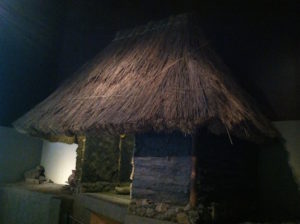Playful figurines, including plump pigs and canine companions, represent scenes of daily life and nature.
Tlatilco figurines, c. 1200–600 B.C.E. (Tlatilco, Mesoamerica, present-day Mexico), ceramic (includes examples from the National Museum of Anthropology, Mexico City as well as the Female Figure at the Princeton University Art Museum). Speakers: Dr. Lauren Kilroy-Ewbank and Dr. Steven Zucker
We don’t know what the people here called themselves. Tlatilco, meaning “place of hidden things,” is a Nahuatl word, given to this “culture” later. Around 2000 B.C.E., maize, squash, and other crops were domesticated, which allowed people to settle in villages. The settlement of Tlatilco was located close to a lake, and fishing and the hunting of birds became important food sources.
Archaeologists have found more than 340 burials at Tlatilco, with many more destroyed in the first half of the 20th century.
[0:00] [music]
Dr. Steven Zucker: [0:04] We’re in the National Museum of Anthropology in Mexico City, and we’re looking at some of the most extraordinary little clay figurines that were from a village in this area in the Valley of Mexico about 3,000 years ago.
Dr. Lauren Kilroy-Ewbank: [0:17] The name of the town was Tlatilco. It had hundreds of burials where you find these amazing figurines.
Dr. Zucker: [0:24] The figurines have extraordinary variety. They give us an insight into what was important to people 3,000 years ago, what they made and then had themselves buried with.
Dr. Kilroy-Ewbank: [0:33] What we’re seeing at Tlatilco is one of the earliest developments of a wide array of objects that display this very advanced visual expression. Right now, we’re standing in front of a series of figurines of individuals with two faces or two heads.
Dr. Zucker: [0:48] The double-headed figures come in a whole variety. There’s one at Princeton University that I’m particularly in love with because it has a bifurcated face with two noses, two mouths, but only three eyes.
Dr. Kilroy-Ewbank: [1:02] It’s a very representative type of Tlatilco female figurine where you have the narrow waist, the broad hips, traces of paint on the face, on the incised hair.
Dr. Zucker: [1:12] This is clay. It would’ve been incised with a sharp instrument to create, for instance, the lines of the hair, and pinched to create forms like the nose.
Dr. Kilroy-Ewbank: [1:22] You typically see red, yellow, or black pigment, and then decorations where you had roller stamps, where you could roll designs over the various surfaces.
Dr. Zucker: [1:31] Some of the figures that we’re seeing here don’t have a combined double face but have two heads.
Dr. Kilroy-Ewbank: [1:37] One of the figurines that we’re looking at right now, you have a single body, so only two legs, two arms, two breasts, but then two individual heads. We see a variety of these here that are relating to this idea of duality.
Dr. Zucker: [1:50] We don’t know what this means because we don’t have a written record to go with this. We’ve got the objects themselves.
Dr. Kilroy-Ewbank: [1:57] This is a great example of where the visual archaeological record is one of the main ways in which we’re able to know about this culture.
Dr. Zucker: [2:05] I’m really taken by this small clay object. There is a single mask-like form but [it] is bifurcated, that is, divided right down the middle.
Dr. Kilroy-Ewbank: [2:14] On the left, you see the face alive, and on the right side, a skeletonized face, the defleshed, dead face.
Dr. Zucker: [2:23] Duality can have lots of different meanings. In the 21st century, when we use that term, we’re often thinking about a kind of East Asian notion of duality, of the yin and the yang. Here in Mexico, what do we know about duality in later cultures where we do have a better record?
Dr. Kilroy-Ewbank: [2:38] If we’re making broad generalizations around this idea of duality, the idea of life and death paired together might relate to the cycle of life. It’s through death that life is able to continue.
Dr. Zucker: [2:49] We usually think about life and then death. You’re saying that people in Mesoamerica thought also about death and then life.
Dr. Kilroy-Ewbank: [2:57] Exactly, that there is this concept that you see consistently about the cycle of life and this idea of regeneration and rebirth.
Dr. Zucker: [3:03] As I look at this mask — it’s too small to be worn, it would fit comfortably in the palm of my hand — the right side is terrifying. It is this skull with that wide, open eye. It’s almost as if we see the grinning of the teeth. On the left side, it’s also unnerving, because it is almost a kind of animal-like face. The tongue is sticking out below the teeth.
Dr. Kilroy-Ewbank: [3:25] The lip has been pulled open as if it is this grimace, which to us reads as threatening or a little terrifying.
Dr. Zucker: [3:32] It’s important to remember that this was found in a burial. We don’t know if it was originally intended for a burial, but that’s where it ended up.
Dr. Kilroy-Ewbank: [3:37] What we find in most in most of these Tlatilco figurines are scenes of daily life and very humorous or charming figurines.
Dr. Zucker: [3:46] There is that small infant in what looks to be a crib, a woman who seems to be kissing a small dog, and another that cradles the dog.
Dr. Kilroy-Ewbank: [3:53] These are some of my favorites. Here we see not only people in daily life but people engaged in types of activities that are truly more intimate, that you don’t see as frequently throughout Mesoamerican art.
Dr. Zucker: [4:05] It’s interesting what you’re saying because there’s so much that carries from the early cultures to the later cultures, but that’s not true here.
Dr. Kilroy-Ewbank: [4:11] We know that in some ways Tlatilco is contemporary with Olmec civilization, which is considered the mother culture of Mesoamerica. Tlatilco is not necessarily influencing — at least, as far as we know right now — later cultures in the same way that, say, the Olmec are.
Dr. Zucker: [4:25] Then there are those amazing animal vessels. They’re so plump and playful.
Dr. Kilroy-Ewbank: [4:30] Some of my favorite[s] include the head of a fish or a duck.
Dr. Zucker: [4:34] These were settled people.
Dr. Kilroy-Ewbank: [4:36] At this point, they’re living more sedentary lives here, say, in the village of Tlatilco, and so they’re able to create ceramics. What we’re seeing here are animals and plants that people are using for food as much as they are to replicate in ceramics, this amazing variety of the natural environment that they see before them.
[4:55] [music]
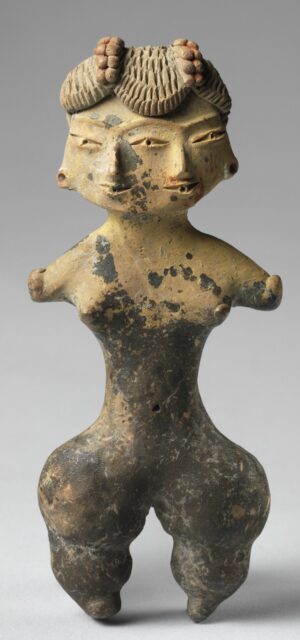
Double-faced female figurine, c. 1200–900 B.C.E. (early formative period, Tlatilco), ceramic with traces of pigment, 9.5 cm high (Princeton University Art Museum)
Intimate and lively
Tlatilco figurines are wonderful small ceramic figures, often of women, found in Central Mexico. This is the region of the later and much better-known Aztec empire, but the people of Tlatilco flourished 2,000–3,000 years before the Aztec came to power in this Valley. Although Tlatilco was already settled by the Early Preclassic period, most scholars believe that the many figurines date from the Middle Preclassic period, or about 1200–400 B.C.E. Their intimate, lively poses and elaborate hairstyles are indicative of the already sophisticated artistic tradition. This is remarkable given the early dates. Ceramic figures of any sort were widespread for only a few centuries before the appearance of Tlatilco figurines.
Appearance
The Tlatilco figurine at the Princeton University Art Museum has several traits that directly relate to many other Tlatilco female figures: the emphasis on the wide hips, the spherical upper thighs, and the pinched waist. Many Tlatilco figurines also show no interest in the hands or feet, as we see here. Artists treated hairstyles with great care and detail, however, suggesting that it was hair and its styling was important for the people of Tlatilco, as it was for many peoples of this region. This figurine not only shows an elaborate hairstyle, but shows it for two connected heads (on the single body). We have other two-headed female figures from Tlatilco, but they are rare when compared with the figures that show a single head. It is very difficult to know exactly why the artist depicted a bicephalic figure (as opposed to the normal single head), as we have no documents or other aids that would help us define the meaning. It may be that the people of Tlatilco were interested in expressing an idea of duality, as many scholars have argued.
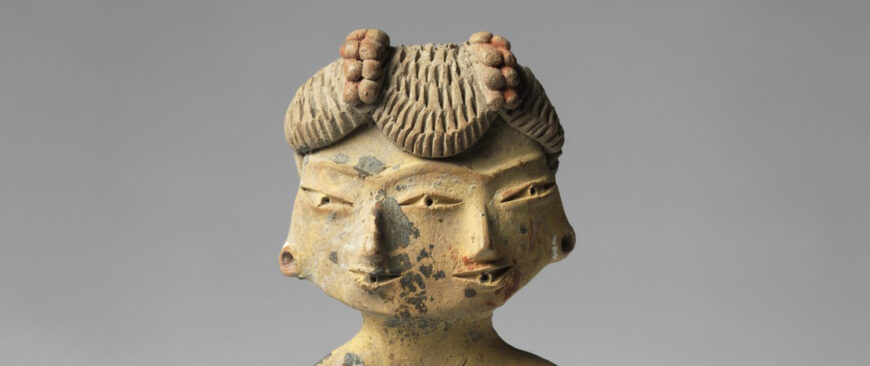
Double faces (detail), Double-faced female figurine, c. 1200–900 B.C.E. (early formative period, Tlatilco), ceramic with traces of pigment, 9.5 cm high (Princeton University Art Museum)
The makers of Tlatilco figurines lived in a large farming villages near the great inland lake in the center of the basin of Mexico. Modern Mexico City sits on top of the remains of the village, making archaeological work difficult. We don’t know what the village would have looked beyond the basic shape of the common house—a mud and reed hut that was the favored house design of many early peoples of Mexico. We do know that most of the inhabitants made their living by growing maize (corn) and taking advantage of the rich lake resources nearby. Some of the motifs found on other Tlatilco ceramics, such as ducks and fish, would have come directly from their lakeside surroundings.
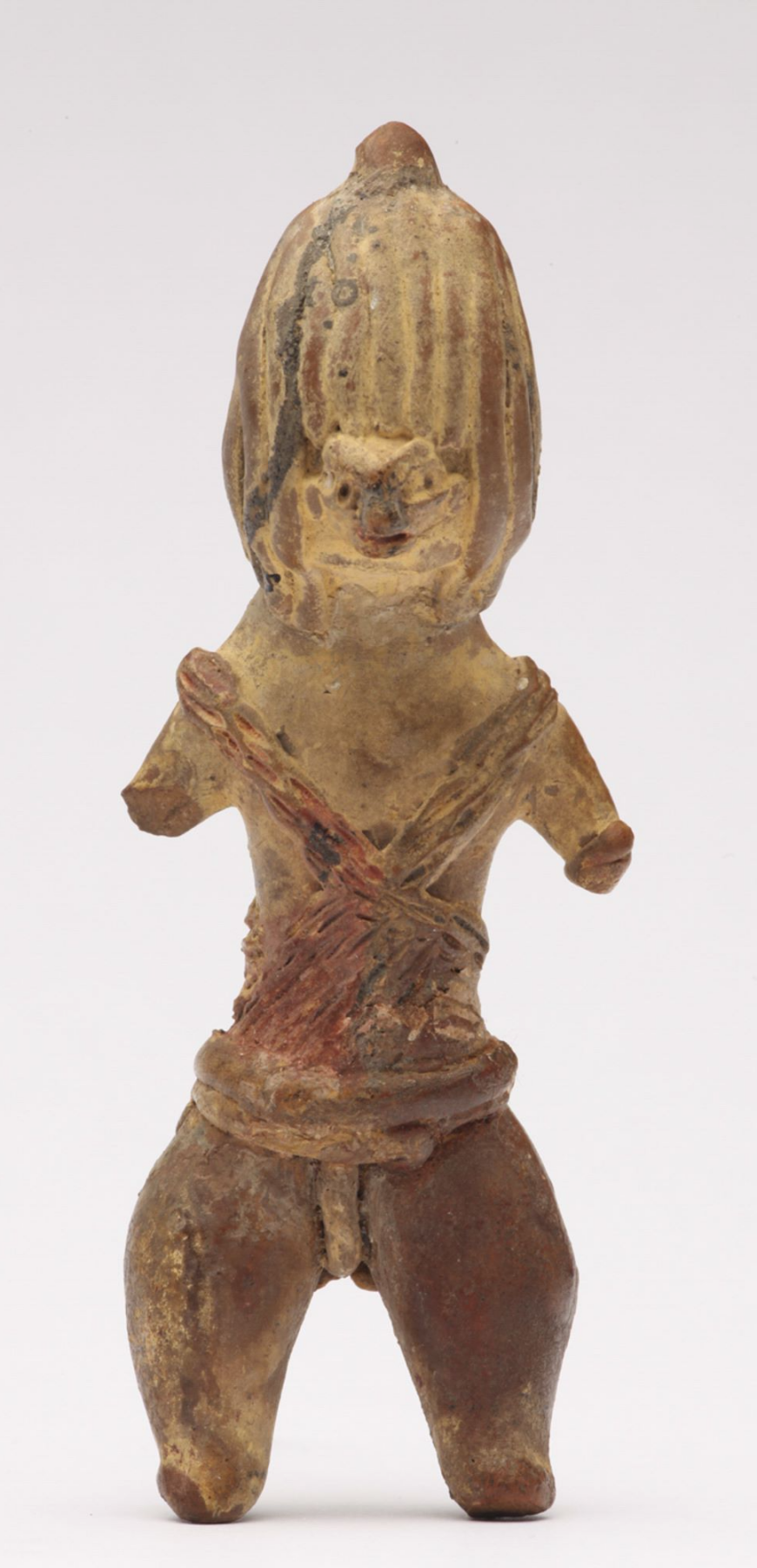
Shaman, c. 1200–600 B.C.E. (Middle Preclassic, Tlatilco), 9.5 cm high (National Museum of Anthropology, Mexico City)
Male figures are rare
Tlatilco artists rarely depicted males, but when they did the males were often wearing costumes and even masks. Masks were very rare on female figures; most female figures stress hairstyle and/or body paint. Thus the male figures seem to be valued more for their ritual roles as priests or other religious specialists, while the religious role of the females is less clear but was very likely present.
How they were found
In the first half of the 20th century, a great number of graves were found by brick-makers mining clay in the area. These brick-makers would often sell the objects—many of them figurines—that came out of these graves to interested collectors. Later archaeologists were able to dig a number of complete burials, and they too found a wealth of objects buried with the dead. The objects that were found in largest quantities—and that enchanted many collectors and scholars of ancient Mexico—were the ceramic figurines.
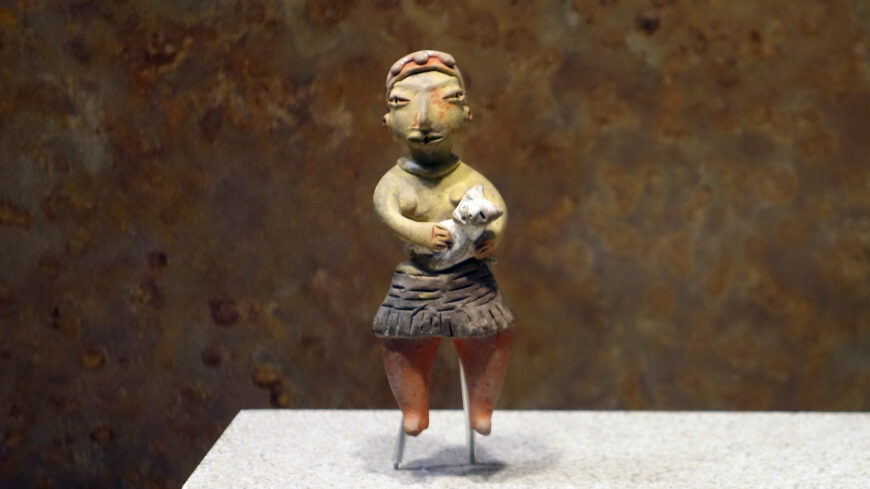
Tlatilco figurine of a woman with a dog, c. 1200–600 B.C.E. (Tlatilco), ceramic (National Museum of Anthropology, Mexico City; photo: Steven Zucker, CC BY-NC-SA 2.0)
Craftsmanship
Unlike some later Mexican figurines, those of Tlatilco were made exclusively by hand, without relying on molds. It is important to think, then, about the consistent mastery shown by the artists of many of these figurines. The main forms were created through pinching the clay and then shaping it by hand, while some of the details were created by a sharp instrument cutting linear motifs onto the wet clay. The forms of the body were depicted in a specific proportion that, while non-naturalistic, was striking and effective. The artist was given a very small space (most figures are less than 15 cm high) in which to create elaborate hairstyles. Even for today’s viewer, the details in this area are endlessly fascinating. The pieces have a nice finish, and the paint that must indicate body decoration was firmly applied (when it is preserved, as in the two-headed figure above). Many scholars doubt that there were already full-time artists in such farming villages, but it is certain that the skills necessary to function as an artist in the tradition were passed down and mastered over generations.

